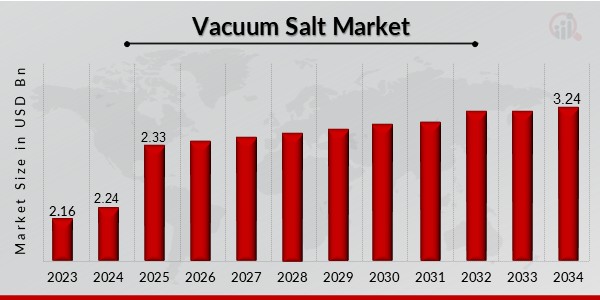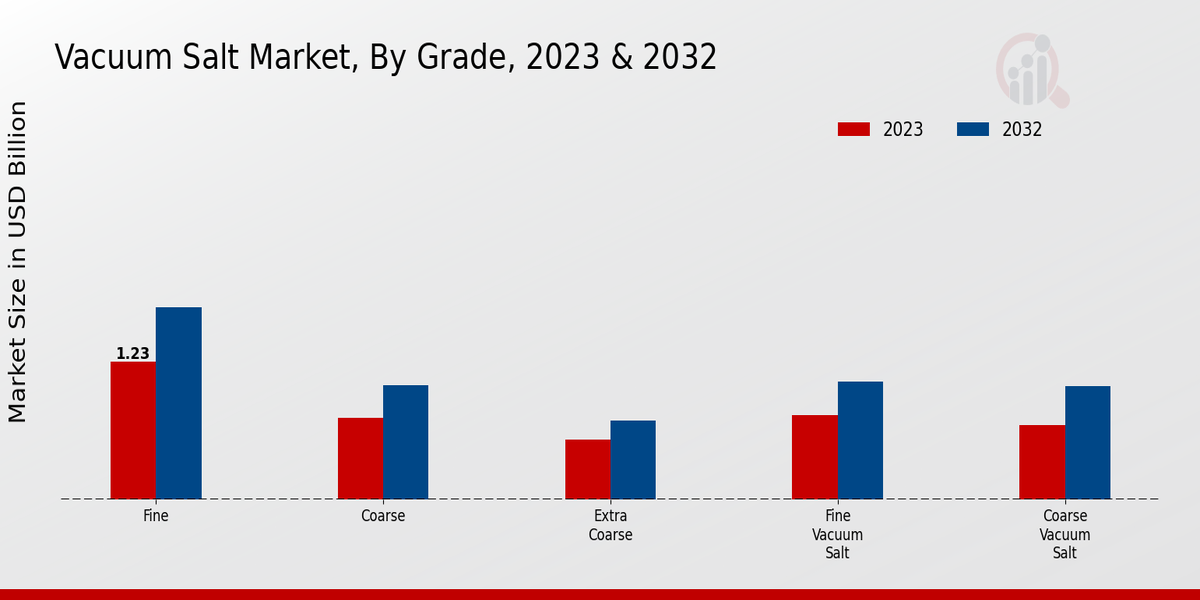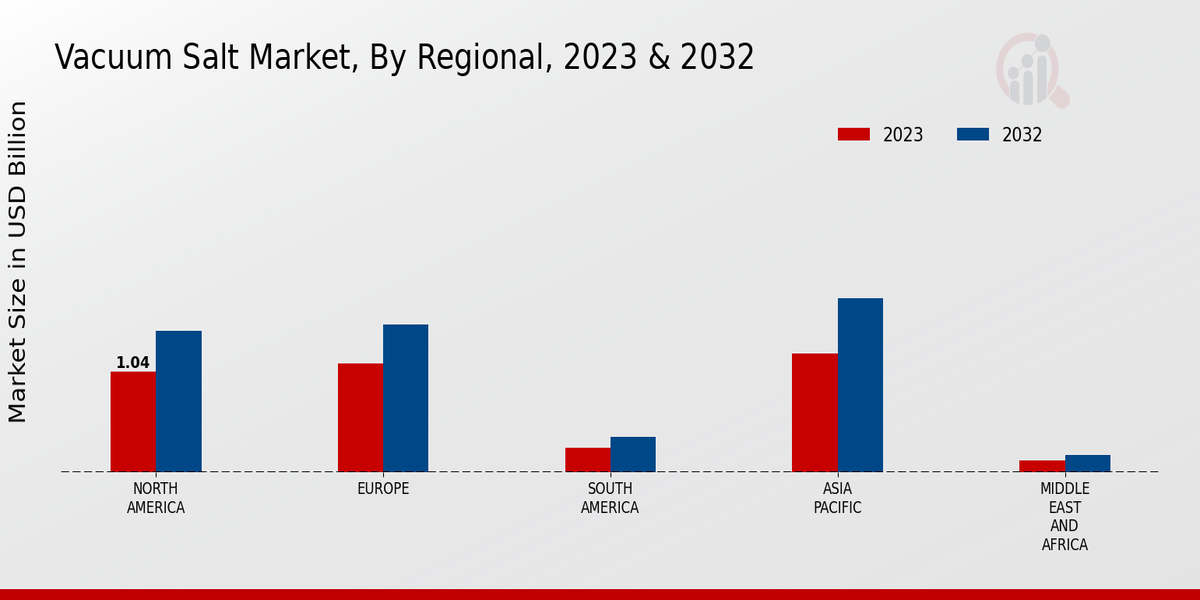Global Vacuum Salt Market Overview
Vacuum Salt Market Size was estimated at 2.24 (USD Billion) in 2024. The Vacuum Salt Industry is expected to grow from 2.33(USD Billion) in 2025 to 3.24 (USD Billion) by 2034. The Vacuum Salt Market CAGR (growth rate) is expected to be around 3.7% during the forecast period (2025 - 2034).

Source Primary Research, Secondary Research, MRFR Database and Analyst Review
Key Vacuum Salt Market Trends Highlighted
Key Market DriversAs consumers aim to lead a healthy life, the growth of the vacuum salt market is also rising since this salt has less sodium content than ordinary salt. The increase in disposable income in developing countries is also raising the market for premium salt products, including vacuum salt.
Opportunities to be Explored
With the growing trend of people cooking and baking more at home, vacuum salt manufacturers have the potential to reach out to home chefs and cooking lovers. Apart from this, the improvement in the food processing sector is likely to create more demand for vacuum salt as a component in food products.
Recent Trends
There has also been a change in the vacuum salt market with respect to the packaging players going green with the use of biodegradable materials and minimizing plastic packaging. We have also witnessed an innovation in the flavoring of vacuum salts whereby herbs, spices, and other natural ingredients have been added to the salt.
Vacuum Salt Market Drivers
Rising Demand for Processed Foods
The growing popularity of processed foods, such as snacks, ready-to-eat meals, and frozen foods, has led to an increased demand for vacuum salt. Vacuum salt is used as a preservative and flavor enhancer in these foods, extending their shelf life and improving their taste. The convenience and affordability of processed foods have made them a staple in many households, driving the demand for vacuum salt. Furthermore, the increasing demand for processed foods in emerging markets is expected to further boost the growth of the vacuum salt market.The Vacuum Salt Market Industry is expected to witness significant growth owing to the rising demand for processed foods.
Growing Health Consciousness
With the increasing concerns about health by consumers, they look for a healthier alternative to the usual table salt. They are considering vacuum salt as the best option as it contains fewer impurities and fewer additives. The production of vacuum salt is a better source of iodine, which is needed to regulate thyroid hormones. Due to these features and with the increasing demand for healthier food, the demand for vacuum salt is likely to increase in the next few years.The Vacuum Salt Market Industry is expected to grow at a moderate rate in the near future due to the increasing health awareness.
Expansion of the Food Service Industry
One of the major trends in the vacuum salt market industry that may affect demand around the world is the expansion of the food service industry. It includes not only restaurants and cafes but also enterprises providing catering services. An increasing amount of vacuum salt is used in the commercial kitchens of such enterprises because this kind of culinary industry requires vacuum salt. It helps to enhance the taste of food and preserve it.In the next decade, this trend is likely to continue.
The matter is that urbanization is becoming more and more profound and people have more disposable income. Following this, restaurants, cafes, and other business enterprises are developing. The number of customers serviced in such enterprises is also increasing. Thus, the demand for vacuum salt in this part of the world is likely to grow.
Vacuum Salt Market Segment Insights
Vacuum Salt Market Grade Insights
The Grade segment of the Vacuum Salt Market is anticipated to grow significantly over the forecast period. Fine Vacuum Salt held the largest market share in 2023, accounting for over 35% of the market. The high demand for this grade is attributed to its versatility and wide range of applications in various industries, including food processing, pharmaceuticals, and water treatment. Coarse Vacuum Salt is projected to witness a steady growth rate during the forecast period, owing to its increasing usage in industrial applications such as deicing and manufacturing detergents.Extra Coarse Vacuum Salt is expected to gain traction in the coming years, driven by its growing popularity in specialty food products and gourmet cooking.
Overall, the Grade segment of the Vacuum Salt Market is expected to exhibit a positive growth trajectory, driven by the rising demand for vacuum salt in various end-use industries. The increasing health consciousness among consumers and the growing adoption of vacuum salt as a healthier alternative to traditional salt are also contributing to the market growth. Additionally, the expanding food and beverage industry and the growing demand for packaged and processed foods are further propelling the demand for vacuum salt.

Source Primary Research, Secondary Research, MRFR Database and Analyst Review
Vacuum Salt Market Application Insights
The vacuum salt market by application is segmented into food, industrial, pharmaceutical, water treatment, and animal feed. The food segment is expected to be the most dominant in the forecast period in 2023 with over 50% market share as the demand for vacuum salt is on the rise for a variety of food processes, snacks and beverages. The industrial segment, on the other hand, will be the fastest-growing segment nearing a CAGR rate of over 4% due to the increasing application of vacuum salt in a range of industrial processes such as paper, textile and other end-use applications.Consequently, the pharmaceutical segment will represent steady growth rates above 3% due to the rising application in pharmaceutical and medical device manufacturing.
The water treatment segment presents modest growth with a relatively low CAGR rate of over 2% due to the increasing application of vacuum salt in a range of water treatment facilities, which demand the compound for various water treatment processes. The animal feed segment will also represent small application demand with a CAGR rate of above 1% due to the increasing application in animal feed formulations.
Vacuum Salt Market Packaging Type Insights
The packaging type segment of the Vacuum Salt Market is classified into bags, drums, bulk, pails, and sacks. Among these, bags held the dominant market share in 2023 and are projected to continue leading throughout the forecast period. Bags offer several advantages, including flexibility, easy handling, and cost-effectiveness. They are also suitable for various applications, making them a preferred choice for vacuum salt packaging. Drums are another significant packaging type in the Vacuum Salt Market. They are robust and provide excellent protection against moisture and contamination, making them suitable for transporting and storing vacuum salt over long distances.Drums are also reusable, contributing to sustainability. Bulk packaging involves transporting vacuum salt in large containers or tankers, typically used for industrial applications.
Bulk packaging offers cost advantages for large-scale transportation but may require specialized equipment for handling. Pails and sacks are also used for vacuum salt packaging, although they have a relatively smaller market share compared to bags and drums. Pails offer convenience and are suitable for smaller quantities, while sacks are commonly used for storing and transporting large volumes of vacuum salt.The choice of packaging type for vacuum salt depends on various factors, including the intended application, transportation requirements, and cost considerations. The market growth for each packaging type is influenced by factors such as technological advancements, demand from end-use industries, and regulatory compliance requirements.
Vacuum Salt Market End-User Insights
Household Consumers, Food Manufacturers, Chemical Industries, Pharmaceutical Companies, and Municipal Water Treatment Facilities are the key end-users of Vacuum Salt in the Vacuum Salt Market. The Vacuum Salt Market segmentation is driven by factors such as increasing demand for vacuum salt in various applications and the growing awareness of the benefits of vacuum salt over traditional salt. Vacuum salt is a healthier alternative to traditional salt as it contains fewer impurities and has a lower sodium content. It is also easier to measure and dispense, making it a convenient choice for home cooking.Food Manufacturers Food manufacturers are increasingly using vacuum salt in their products to enhance flavor and extend shelf life. Vacuum salt is a natural preservative that helps to inhibit the growth of bacteria and mold. It also helps to retain moisture in food, preventing it from drying out. Chemical Industries Vacuum salt is used in the chemical industry to produce a variety of chemicals, including chlorine, sodium hydroxide, and hydrochloric acid. Vacuum salt is also used in the production of plastics, detergents, and paper. Pharmaceutical Companies Vacuum salt is used in the pharmaceutical industry to produce a variety of drugs and medical devices.Vacuum salt is used as an excipient in tablets and capsules, and it is also used in the production of intravenous fluids and solutions. Municipal Water Treatment Facilities Vacuum salt is used in municipal water treatment facilities to remove impurities from water. Vacuum salt helps to coagulate suspended solids, making them easier to remove from the water. It also helps to reduce the hardness of water, making it more suitable for drinking and other uses.
Vacuum Salt Market Regional Insights
The regional segmentation of the Vacuum Salt Market provides insights into the market's geographical distribution and performance. North America holds a significant market share due to the presence of established food and beverage industries and a high demand for convenience foods. Europe follows closely, driven by consumer preference for packaged food products and the presence of major food manufacturers. APAC is projected to witness substantial growth over the forecast period, attributed to rising disposable incomes, expanding population, and increasing urbanization.South America and MEA represent emerging markets with growing potential, supported by expanding consumer spending and the development of local food industries.

Source Primary Research, Secondary Research, MRFR Database and Analyst Review
Vacuum Salt Market Key Players And Competitive Insights
The players in the Vacuum Salt Market are heavily investing in R and D investments to introduce new advanced products and technologies in this market, which is ratcheting up the intensity of the competition. Leading market players are expanding their product lines and attempting to diversify their distribution channels to cater to the rapidly changing demands of their customers. Major players in the vacuum salt market are likely to witness the entry of new players, mergers and acquisitions, and strategic alliances through the course of the next decade. They are defining the competitive tilt in the vacuum salt market and influencing the overall market development.
Among the key players in the industry is AkzoNobel, a leading player that is associated with the chemical industry. The company has a wide range of vacuum salt products, which includes food-grade, industrial-grade, pharmaceutical-grade active salts, and Arkos, a low sodium vacuum active fluoride salt. The company has a presence in many countries around the world, including Australia, Belgium, Egypt, Denmark, Germany, France, the UK, the US, and Sweden. Importantly, the company is strongly committed to R and D and is focused on developing and applying innovative concepts to improve its product mix and manufacturing processes.
Cargill, a leading provider of food, agriculture, and financial solutions, is another important player in the vacuum salt market. The company’s wide range of salt products includes rock salt, vacuum salt, and sea salt, and it has a production and distribution presence in various regions around the world, serving its customers efficiently. The company is focused on sustainability and reducing its environmental impact through prudent methods of responsible sourcing and manufacturing.
Key Companies in the Vacuum Salt Market Include
- Tata Chemicals
- FMC Corporation
- Cargill
- Himalayan Salt Company
- ICL Group
- Martin's Salt
- Israel Chemical Industries
- The Salt Cellar
- Diamond Crystal Brands
- AkzoNobel
- Leslie Salt
- Morton Salt
- Salins du Midi Group
- K+S
- Compass Minerals
Vacuum Salt Market Industry Developments
The vacuum salt market is projected to grow from USD 2.08 billion in 2023 to USD 2.9 billion by 2032, exhibiting a CAGR of 3.74% during the forecast period. This growth can be attributed to the increasing demand for vacuum salt in various industries, including food processing, pharmaceuticals, and water treatment. For instance, in the food industry, vacuum salt is widely used as a flavor enhancer and preservative in products such as processed meats, snacks, and sauces.Recent developments in the vacuum salt market include the launch of new products and technologies. For example, in 2023, Cargill introduced a new range of vacuum salt products designed to meet the specific needs of food manufacturers. These products offer improved flavor and texture while reducing the amount of salt used in formulations.Key players operating in the vacuum salt market include AkzoNobel, Cargill, Compass Minerals, and Morton Salt. These companies are focusing on expanding their production capacities and introducing innovative products to cater to the growing demand.
Vacuum Salt Market Segmentation Insights
-
Vacuum Salt Market Grade Outlook
-
Fine
-
Coarse
-
Extra Coarse
-
Fine Vacuum Salt
-
Coarse Vacuum Salt
-
Vacuum Salt Market Application Outlook
-
Food
-
Industrial
-
Pharmaceutical
-
Water Treatment
-
Animal Feed
-
Vacuum Salt Market Packaging Type Outlook
-
Bags
-
Drums
-
Bulk
-
Pails
-
Sacks
-
Vacuum Salt Market End-User Outlook
-
Vacuum Salt Market Regional Outlook
-
North America
-
Europe
-
South America
-
Asia Pacific
-
Middle East and Africa
| Report Attribute/Metric |
Details |
| Market Size 2024 |
2.24(USD Billion) |
| Market Size 2025 |
2.33(USD Billion) |
| Market Size 2034 |
3.24(USD Billion) |
| Compound Annual Growth Rate (CAGR) |
3.7% (2025 - 2034) |
| Report Coverage |
Revenue Forecast, Competitive Landscape, Growth Factors, and Trends |
| Base Year |
2023 |
| Market Forecast Period |
2025 - 2034 |
| Historical Data |
2019 - 2023 |
| Market Forecast Units |
USD Billion |
| Key Companies Profiled |
Tata Chemicals, FMC Corporation, Cargill, Himalayan Salt Company, ICL Group, St. Martin's Salt, Israel Chemical Industries, The Salt Cellar, Diamond Crystal Brands, AkzoNobel, Leslie Salt, Morton Salt, Salins du Midi Group, K+S, Compass Minerals |
| Segments Covered |
Grade, Application, Packaging Type, End-User, Regional |
| Key Market Opportunities |
Rising health consciousness increasing demand in food industry, expanding applications in the chemical industry, growing popularity in water softening |
| Key Market Dynamics |
Rising consumer preference for healthy salts Growing demand from the food and beverage industry Technological advancements in vacuum salt production Increasing disposable income in emerging economies Expanding application in pharmaceutical and cosmetic industries |
| Countries Covered |
North America, Europe, APAC, South America, MEA |
Frequently Asked Questions (FAQ) :
The Vacuum Salt Market was expected to reach a valuation of USD 3.24 billion by 2034, expanding at a CAGR of 3.7% from 2025 to 2034.
North America is anticipated to dominate the market over the forecast period, owing to the rising demand for vacuum salt in food processing and industrial applications.
Vacuum salt finds extensive applications in food processing, water treatment, and pharmaceuticals, among other industries.
Leading players in the Vacuum Salt Market include Compass Minerals, Cargill, and Tata Chemicals.
Fluctuating raw material costs and stringent environmental regulations pose challenges to the growth of the Vacuum Salt Market.
The Vacuum Salt Market is expected to witness steady growth over the forecast period, driven by the increasing demand for processed foods and the expansion of water treatment facilities.
Technological advancements, such as the development of more efficient vacuum evaporation systems, are expected to enhance the production and quality of vacuum salt, further driving market growth.
The Vacuum Salt Market is segmented based on grade, application, and region.
Growing consumer awareness about the health benefits of vacuum salt and the increasing use of vacuum salt in niche applications are key trends shaping the market.
New entrants can explore opportunities in emerging markets, focus on product innovation, and target specific applications to gain a competitive edge.

















